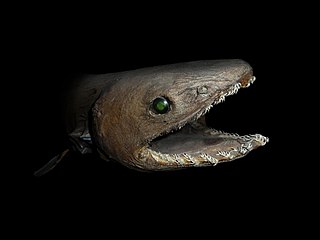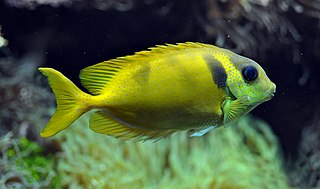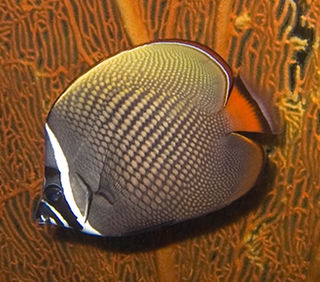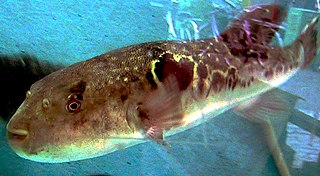
The coelacanths are members of a now-rare order of fish (Coelacanthiformes) that includes two extant species in the genus Latimeria: the West Indian Ocean coelacanth, primarily found near the Comoro Islands off the east coast of Africa, and the Indonesian coelacanth. The name originates from the Permian genus Coelacanthus, which was the first scientifically named coelacanth.

Molecular evolution is the process of change in the sequence composition of cellular molecules such as DNA, RNA, and proteins across generations. The field of molecular evolution uses principles of evolutionary biology and population genetics to explain patterns in these changes. Major topics in molecular evolution concern the rates and impacts of single nucleotide changes, neutral evolution vs. natural selection, origins of new genes, the genetic nature of complex traits, the genetic basis of speciation, evolution of development, and ways that evolutionary forces influence genomic and phenotypic changes.

The axolotl, Ambystoma mexicanum, is a paedomorphic salamander related to the tiger salamander. The species was originally found in several lakes, such as Lake Xochimilco underlying Mexico City. Axolotls are unusual among amphibians in that they reach adulthood without undergoing metamorphosis. Instead of taking to the land, adults remain aquatic and gilled.

The frilled shark and the southern African frilled shark are the two extant species of shark in the family Chlamydoselachidae. The frilled shark is considered a living fossil, because of its primitive, anguilliform (eel-like) physical traits, such as a dark-brown color, amphistyly, and a 2.0 m (6.6 ft)–long body, which has dorsal, pelvic, and anal fins located towards the tail. The common name, frilled shark, derives from the fringed appearance of the six pairs of gill slits at the shark's throat.

Neopterygii is a subclass of ray-finned fish (Actinopterygii). Neopterygii includes the Holostei and the Teleostei, of which the latter compromise the vast majority of extant fishes, and over half of all living vertebrate species. While living holosteans include only freshwater taxa, teleosts are diverse in both freshwater and marine environments. Many new species of teleosts are scientifically described each year.

The marginated tortoise is a species of tortoise in the family Testudinidae. The species is endemic to Greece, Italy, and the Balkans in Southern Europe. It is the largest European tortoise. The marginated tortoise is herbivorous, and hibernates for the winter.
The abyssal zone or abyssopelagic zone is a layer of the pelagic zone of the ocean. "Abyss" derives from the Greek word ἄβυσσος, meaning bottomless. At depths of 3,000 to 6,000 metres, this zone remains in perpetual darkness. It covers 83% of the total area of the ocean and 60% of the Earth's surface. The abyssal zone has temperatures around 2 to 3 °C through the large majority of its mass. Due to there being no light, there are no plants producing oxygen, which primarily comes from ice that had melted long ago from the polar regions. The water along the seafloor of this zone is actually devoid of oxygen, resulting in a death trap for organisms unable to quickly return to the oxygen-enriched water above. This region also contains a much higher concentration of nutrient salts, like nitrogen, phosphorus, and silica, due to the large amount of dead organic material that drifts down from the above ocean zones and decomposes. The water pressure can reach up to 76 megapascal.

The pelican eel is a deep-sea eel rarely seen by humans, though it is occasionally caught in fishing nets. It is the only known member of the genus Eurypharynx and the family Eurypharyngidae. It belongs to the "saccopharyngiforms", members of which were historically placed in their own order, but are now considered true eels in the order Anguilliformes. The pelican eel has been described by many synonyms, yet nobody has been able to demonstrate that more than one species of pelican eel exists. It is also referred to as the gulper eel, pelican gulper, and umbrella-mouth gulper. The specific epithet pelecanoides refers to the pelican, as the fish's large mouth is reminiscent of that of the pelican.

The mosaic gulper shark is a small rare deepwater dogfish, found in the Pacific Ocean around Honshū, Japan and the Hawaiian Islands at depths between 260 and 728 m. It is one of 13 described species in the genus Centrophorus.

The Nile tilapia is a species of tilapia, a cichlid fish native to the northern half of Africa and the Levante area, including Palestine, and Lebanon. Numerous introduced populations exist outside its natural range. It is also commercially known as mango fish, nilotica, or boulti. The first name leads to easy confusion with another tilapia which is traded commercially, the mango tilapia.

Saccopharynx is a genus of deep-sea eels with large mouths, distensible stomachs and long, scaleless bodies. Commonly, these fish are called gulpers or gulper eels. It is the only genus in the family Saccopharyngidae, and is part of the derived lineage of the "saccopharyngiforms," which includes other mid-water eel species. The name is from Latin saccus meaning "sack" and Greek φάρυγξ, pharynx.

The smalltooth sand tiger or bumpytail ragged-tooth is a species of mackerel shark in the family Odontaspididae, with a patchy but worldwide distribution in tropical and warm temperate waters. They usually inhabit deepwater rocky habitats, though they are occasionally encountered in shallow water, and have been known to return to the same location year after year. This rare species is often mistaken for the much more common grey nurse shark, from which it can be distinguished by its first dorsal fin, which is larger than the second and placed further forward. It grows to at least 4.1 m (13.5 ft) in length.

The bigeye sand tiger is an extremely rare species of mackerel shark in the family Odontaspididae, with a possible worldwide distribution. A large, bulky species reaching at least 3.6 m (12 ft) in length, the bigeye sand tiger has a long bulbous snout, large orange eyes without nictitating membranes, and a capacious mouth with the narrow teeth prominently exposed. It can be distinguished from the similar smalltooth sand tiger by its teeth, which have only one lateral cusplet on each side, and by its uniformly dark brown color.

The viper dogfish or viper shark is a rare species of dogfish shark in the family Etmopteridae, and the only extant member of its genus. It has been found in the Pacific Ocean off southern Japan, the Bonin Islands, Pacific Ocean off northern Taitung County and the Northwestern Hawaiian Islands. This species inhabits upper continental slopes and seamounts. It may migrate vertically, shifting between bottom waters 270–360 m (890–1,180 ft) deep during the day and upper waters less than 150 m (490 ft) deep at night. A slender, black shark reaching 54 cm (21 in) in length, the viper dogfish can be recognized by its narrow, triangular jaws and well-spaced, fang-like teeth. It also has two spined dorsal fins, dermal denticles with faceted crowns, and numerous light-emitting photophores concentrated on its ventral surface.

The Atlantic sawtail catshark is a little-known species of catshark, part of the family Scyliorhinidae, found in a small area of the northeastern Atlantic Ocean, centered on the Strait of Gibraltar and the Alborán Sea. It is found on or close to the bottom over the continental slope, mostly at depths of 400–600 m (1,300–2,000 ft). This shark closely resembles, and was once thought to be the same species as, the blackmouth catshark ; both are slender with a series of dark saddles and blotches along the back and tail, and a prominent crest of enlarged dermal denticles along the dorsal edge of the caudal fin. It differs subtly from G. melastomus in characters including snout length, caudal peduncle depth, and the color of the furrows at the corner of its mouth.

The red-tailed butterflyfish, also known as the brown butterflyfish, Pakistani butterflyfish or redtail butterflyfish, is a species of marine ray-finned fish, a butterflyfish belonging to the family Chaetodontidae.

Takifugu rubripes, commonly known as the Japanese puffer, Tiger puffer, or torafugu, is a pufferfish in the genus Takifugu. It is distinguished by a very small genome that has been fully sequenced because of its use as a model species and is in widespread use as a reference in genomics. As with several other species in its genus, T. rubripes is prized for its use in fugu dishes in Japan and South Korea. Overfishing has caused damage to some fisheries, and the species is considered Near Threatened by the IUCN; however, T. rubripes is also raised in aquaculture in addition to being caught from the wild.

The Denisovans or Denisova hominins(di-NEE-sə-və) are an extinct species or subspecies of archaic human that ranged across Asia during the Lower and Middle Paleolithic. Denisovans are known from few remains, and, consequently, most of what is known about them comes from DNA evidence. No formal species name has been erected pending more complete fossil material.

The Indonesian angelshark is a rare species of angelshark, family Squatinidae, known only from a few specimens collected from fish landing sites in southern Indonesia. It is thought to inhabit the deep waters of the continental slope. Reaching at least 1.34 m (4.4 ft) long, this species has a flattened, ray-like shape and a well-developed tail and caudal fin. It is characterized by the absences of fringes on its nasal barbels and thorns down the midline of its back, as well as by its relatively plain grayish-brown dorsal coloration with dark saddles beneath the dorsal fin bases and a black leading margin on the underside of the pectoral fins. The International Union for Conservation of Nature (IUCN) has classified it as Critically Endangered due to significant fishing pressure.

Saccopharynx ampullaceus, referred to as the gulper eel, gulper, taillight gulper or pelican-fish, is an ocean-dwelling eel found in the North Atlantic Ocean. They are found up to a depth of 3,000 m (9,800 ft). These fish are rarely observed, so little information is currently known about their habits or full distribution.


















